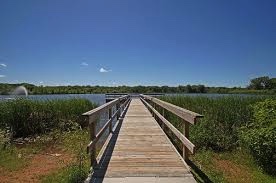Is Lake Cornelia Toxic?

Lake Cornelia
October 5, 2016
Recently Lake Cornelia has been announced toxic by the City of Edina and Nine Mile Creek Watershed District. There have been tweets, articles, and many other recent warnings about this issue, telling people and pets to stay away from the water. The lake is “toxic” but what does that really mean?
What many people don’t realize is it’s not the actual lake that is toxic, but the algae that is found in it. High blue-green algae levels were found in the lake, along with high microcystin toxin levels that go along with a large amount of blue-green algae growth. Blue-green algae, which can also be known as cyanobacteria, uses the sunlight to grow, and as a result produces many health endangering toxins (such as microcystin). The ideal growing period for these microcystin toxins is late summer and early fall, and when released they may be evident for the next few weeks or even months. When released, the toxins “bloom” which creates a dark green mushy blob. Typically, there is also a strong odor that comes along with this toxin and it may smell sulfuric during this time. These toxins are very harmful for the water, and anyone who comes in contact with it. When microcystin is absorbed by humans, it can cause liver damage, rashes, blistering, or burns. Ingesting this toxin becomes much more serious and it will first attack your liver and kill off many cells, but can also cause vomiting, nausea, headaches, pneumonia, or fevers. There have been cases where pets have died from microcystin inhalation, but there has never been a reported human death. This toxin also kills off many fish and other wildlife that is important to our ecosystems. The growth of this toxin is endangering to anyone who comes in contact with it.
The Nine Mile Creek and Watershed District and City of Edina are currently working to find solutions and control the algae growth. The basis of the problem is found in the phosphorous pollution Lake Cornelia is exposed to. Erica Sniegowski, the Nine Mile Creek Watershed District Education and Outreach Manager, states, “Our infrastructure was designed to collect runoff from streets. This runoff flows untreated to local bodies of water. Pollutants gather in these areas and often create high levels of phosphorus, which can lead to harmful algal blooms.” Lake Cornelia’s algae levels are being carefully watched and the lake is is regularly upkept by lake restoration companies and given periodical algae treatments. What citizens can do is most importantly just avoid the lake and coming in contact with the water. For many of us that probably won’t be an issue since Lake Cornelia isn’t the prime swimming location. Also, keeping pets on leashes around the lake can prevent them from accidently coming in contact with the water.

